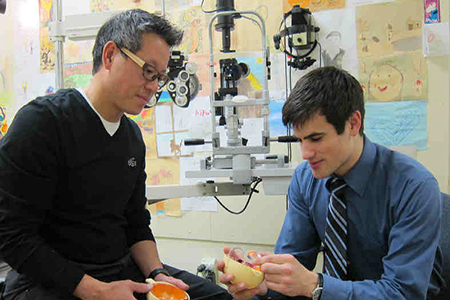Art is expanding like never before-in new and exciting directions. Some of the fastest-growing art careers are in “nontraditional” fields like fashion design gaming and multimedia design.
Today the fine arts are as varied as they are creative-from “traditional” art (painting sculpting photography etc.) to “applied arts” (industrial and environmental design)-and today’s fine arts programs reflect that diversity.
Across the country fine arts students are as likely to be found in front of a computer as they are in front of an easel. With the development of new media students are venturing into a wide array of dynamic programs such as graphic design animation motion graphics editorial design and video production. These programs which often draw upon multiple disciplines allow students to flex their creativity and strengthen their range as artists-a diversity that is valuable to future employers.
As art continues to take center stage affecting everything from our landscape to our consumer choices art and design programs evolve and strengthen. Environmental and product design programs have expanded in response to concerns over sustainability material usage and design innovation.
If you think a career in the arts is right for you your next step is to decide which type of school you’d like to attend in order to obtain your bachelor of fine arts (BFA) degree. You can study at a specialized art school or in the art department of a traditional college or university. Keep in mind that a BFA must have a certain ratio of liberal arts to studio courses no matter the school and that specialty art schools typically offer a strong liberal arts curriculum.
Whichever path you choose remember that fine arts and design programs can be highly competitive. Here’s what you need to know about applying.
Know Your Audience
Do your research. Check out the websites of the schools you’re interested in applying to. Find out what programs and courses are offered; who the faculty members are; and what connections the school has to museums galleries and art/design firms. Many school sites feature student image collections which are useful to determine the kind of work that students create at a particular school. Look for schools whose programs and art speak to your interests. Investigate how the graduates of a school have fared in obtaining art- or design-related jobs.
“Research is the key,” says Scott Ramon, executive director of admissions at the School of the Art Institute of Chicago. “Collect catalogs from schools and see what kind of work is being created at that college … Go to contemporary galleries in your town or city. Find artists and designers who are currently practicing. Visit colleges and attend their end of- the-year exhibitions.”
If possible visit the schools you are considering. In person you can get a better sense of the school’s facilities equipment environment and student body. If you can’t visit see if you can speak with a current student who is studying in your field.
Put Pen to Paper (or Mouse to Monitor)
Colleges are looking for dedication and determination in their art and design applicants. Your application should reflect your commitment to your work and to the field of art. While transcripts recommendations and test scores are important your art portfolio will be a crucial component of your application.
You should begin to think about your portfolio long before you fill out your applications. “If you don’t keep a sketchbook start,” says Judith Aaron, vice president for enrollment at the Pratt Institute in New York City. “And draw draw draw.”
Even if drawing isn’t required in your portfolio or directly related to your desired major-such as digital media or photography-it’s an important skill to develop. “The exercise of drawing strengthens the connection between what you see and how you as an artist interpret what you see” says Sandy Britton, director of enrollment management at Kendall College of Art and Design of Ferris State University.
At the same time don’t be afraid to branch out says Kathleen Keenan interim dean of admissions at Massachusetts College of Art and Design (Mass- Art). “Challenge yourself by trying different media even ones that are outside of your comfort zone. Understand that not everything you produce will go into your final portfolio so produce a lot so you can be choosy in the end.”
Many art schools like the Maryland Institute College of Art (MICA) offer summer portfolio camps where high school students can build their portfolios work with fellow artists and receive critiques from college faculty.
“The precollege summer program is a wonderful way for students to really develop their artistic skills and build a portfolio,” says Theresa Bedoya, vice president for admission and financial aid at MICA. In addition to observational drawings (which many schools require) include pieces in your portfolio that best reflect your talents areas of interest and diversity as an artist. However it’s not necessary to show one of everything in your portfolio. Donna Moran of the Pratt Institute says to include “no more than 20 pieces” and adds that “10 good ones are better.”
Bring your portfolio to a National Portfolio Day near you. These events take place throughout the country and provide art students with an excellent opportunity to meet with college representatives from a number of prominent schools. These representatives will be available to discuss their programs review your work and offer feedback.
While a solid portfolio is vital do not overlook the other components of your application. “Many prospective applicants are surprised to learn that we often deny more applications on the basis of a weak academic record than a below average portfolio,” says Ama Schulman, admissions counselor at MICA.
“Each school is a little different,” says Debra Gibbs, admissions counselor at Parsons The New School for Design. “We take a holistic approach and look at the whole student. Grades are as important as the portfolio. We also require the student to complete the ‘Parsons Challenge’ which is an additional assignment where they have to use creative problem-solving and conceptual thinking.”
Strong recommendations a passionate personal statement and a good interview can help identify you as an individual setting you apart from other talented hopefuls.
| SALARIES | |
| You may be wondering how much artists, designers and other creative professionals earn. Here are the mean national salaries for certain careers open to graduates with fine arts and design degrees. Keep in mind that salaries vary by location. Additionally, as these are average salaries among all individuals in the specified field, starting salaries will typically be less. | |
| Art Directors | $83,230 |
| Commercial and Industrial Designers | $60,540 |
| Fine Artists, Including Painters, Sculptors and Illustrators | $48,110 |
| Graphic Designers | $45,340 |
| Fashion Designers | $71,170 |
| Interior Designers | $50,190 |
| Multimedia Artists and Animators | $61,010 |
Art is Everywhere
From product design to landscape design from animation to film production art is venturing into new fields creating new expressions and possibilities. Students interested in traditional graphic design now need to consider learning web design as well which involves a different skill set. Students in MICA’s curatorial studies program research plan and implement all components of mounting a major exhibition including curatorial decisions interpretive texts exhibition design public programming public relations publication and web design.
Joan Livingstone, professor and chair in the Department of Fiber and Material Studies at the School of the Art Institute of Chicago notes that artists are exploring “a wide range of fabrication technologies … including the traditions of painting and sculpture … as well as digital facilities with 3-D modeling rapid prototyping image processing … and media editing.”
A similar approach is taken in the Studio for Interrelated Media major at MassArt where students “combine the study of many media pursuing the realization of their ideas with the most appropriate media for each new project,” says Keenan.
Many art programs emphasize the importance of practical industry-related experience; internship programs are strongly encouraged and often required.
Of course in the current economic climate most students are interested in how they’ll find a job when they graduate notes Aaron of Pratt. The first place to look is your school’s career services center which can provide information on internships networking events and faculty affiliations. Ask teachers and counselors for help in identifying the galleries design houses and companies most closely aligned with your area of focus. And finally remember to always keep your portfolio filled with your best work.
Pauline Estrem is a freelance writer in Chicago, IL.



